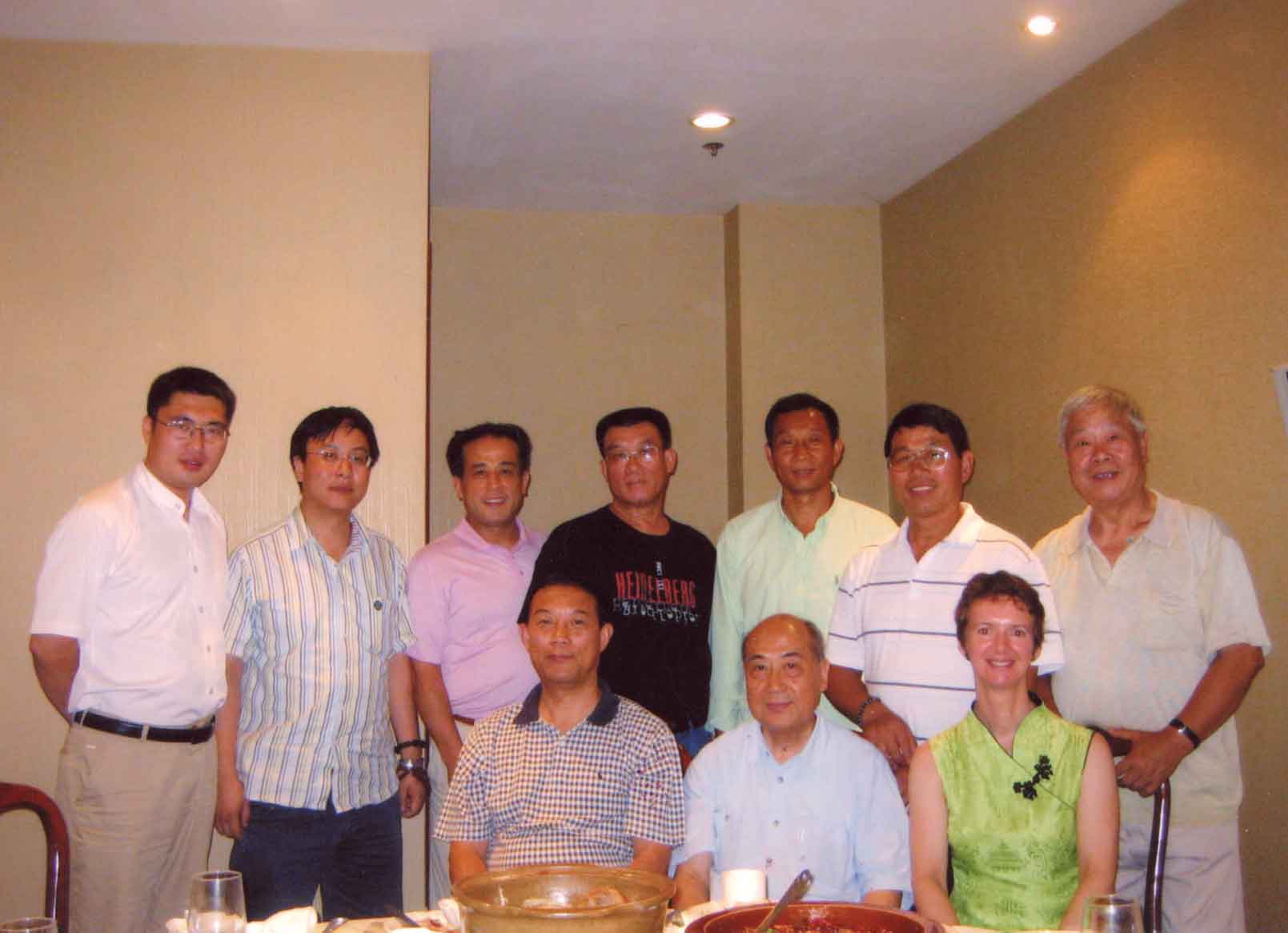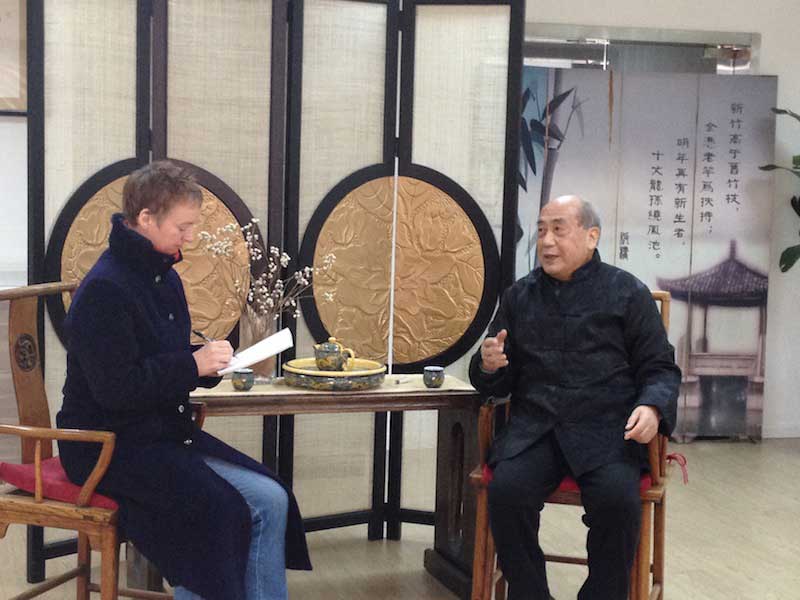Yang Style ‘Secret’ Energy Lines – An Interview with Professor Qu Shi Jing
Meeting with scholar and Taiji enthusiast, Professor Qu Shi Jing in Shanghai, I discussed his understanding of Yang Style Taiji’s ‘secret’ energy lines that interconnect the entire body.

Rose & Various Masters with Qu Shi Jing & Yu Ding Hai
These energy lines shouldn’t be confused with TCM energy channels, as they are not the same as TCM’s meridian system, although may share a few similar pathways. These ‘Taiji’ energy lines are a form of grid that connect through the body laterally, horizontally and segment the trunk, helping form a global energy structure essential for both fajing (explosion and release of outward force) and hua jing, (dissipation of incoming force).
Professor Qu Shi Jing, an 83-year old Shanghai native and Professor of English Literature and Director of the English Literature Studies Centre and Academy of Social Sciences here in Shanghai, was a student of the late Master Huang Jing Hua, a pupil of Grandmaster Yang Cheng Fu; beginning his study of Yang Style when he was 14-years old, over 65 years ago. Huang Jing Hua and Cheng Man Ching (Zheng Man Qing) co-authored a popular book on Taiji Quan, a record of Yang Cheng Fu’s teachings.
And while Qu says his teacher didn’t have strong Neijing, or internal power, he was excellent at neutralizing others’ incoming force.
More of a scholar than a fighter, Professor Qu first became interested in the art due to ill health, as so many Taiji practitioners do. However, it was his years as a simple soldier on guard duty, which were the precursor to really attaining bodily understanding of Yang Style Taiji’s energy and body connectors.
While holding standing postures is often cited as a way to realize and gain awareness of energy movement and connection through the body, the inescapable duty of standing to attention for many hours on end, helped Qu finally feel how once he maintained a relaxed, fixed posture, without the possibility of any other external movement, the channels could finally superimpose their will on the tired physical, muscular structure, and thus make their presence not only felt, but also activated and connected, as energy was moved first from the bubbling wells of the feet to the dantian, and then finally all through the body on command.
In describing Neijing (内劲), Qu recounted the comparison of using a stick to prod at someone, or using a syringe to inject/fire at them.
The whole stick needs to move forward of itself and strike/prod the person, likening the phenomenon to Waijing (外劲), or external visible movement. However, the syringe need not advance any further toward a person or be used to prod at them; it is held in place and the plunger forms pressure behind the liquid and when pushed forward inside the syringe, drives the inner air or liquid outwards with force. The syringe is thus simply a vehicle or channel for the inside liquid to be pushed through, forming an internal or invisible energy channel.
This then is the energetic parable practitioners need to focus on when seeking to huajing or fajing opponents: arms or contact points don’t force or push forward, it is the energy created through the energy lines and circles that power through the contact points that distribute the force.
Speaking of the energy lines, Qu describes them as nine interconnecting lines, rings and circles.
For many practitioners, Qu included, internal energy often remains stuck in the dantian, it doesn’t truly manifest through to the extremities, and thus practitioners continue to use physical and structural force when applying techniques, or at best they try to readjust the flow of their energy physically, which slows the process, often resulting in the need for external force to execute a technique.
However, if one can gain mastery over these 9 channels, then the physical body can become the foot soldier of the body’s energy, ready to deliver its force at a heartbeat; not a ‘commander’, which only restricts its own army’s potential power.
LINES, RINGS & CIRCLES
Qu described the lines as three distinct straight lines; 3 rings and 3 circular lines.
The three horizontal circles:
The three rings connect to the vertical circles:
The three straight lines:
The nine lines transect the trunk, with three running longitudinally each side of the spine, separate from the governing and conceptual vessels. The three remaining lines run horizontally; connecting through the hip and sacral areas, the waist and abdominal region, and finally the chest area; basically encompassing the lower and middle dantians.
As these horizontal lines are ‘transected’ by the lateral lines, the body is effectively woven together so that the limbs and torso form the hull of a ship and the tendons, ligaments and muscles are nicely intersected by the energy lines, to form rigging ready for the energy to fill the sails and make the body move.
To fully utilize these lines in movement also requires a sensation of the meridian and acupuncture point system within TCM theory; the Governing and Conceptual vessels house the yin/yang elements of energy flow through the body; the meridians and associated points that run through the hands and feet are also interconnected to the dantian and ultimately to the governing and conceptual vessels. One breath can therefore connect all energy channels within the body.
Qu explained that the connection of these lines is micro-second timing, like a lightening flash, a pulsation of energy, rather than a structural heave as it were, if the Taiji practitioner is to react to an opponent’s incoming force and either dissipate or issue their own power.
To master the energy pathways requires diligence, practice and of course informed instruction, but the first steps are Zhan Zhuang, or standing postures. A basic understanding of the body’s meridians and acupuncture points in TCM theory are also necessary for informed practice of standing postures; this (along with a teacher’s advice) will assist students to adjust their bodies to the correct alignment to allow energy to flow, and the heart-mind to be still to help guide the feeling of energy movement along the prescribed meridian channels.
This should not be ‘chaotic’ or casual exercise; haphazardly leading energy anywhere, and not through the specified meridian channels as per TCM can lead to blockages, and at worst health problems, mental and physical, so a proper understanding and discipline is essential.
Once some sensation of energy travel through the meridians is achieved, then one can start to direct the energy to the feet; to the Ming Men; to the Jia Qi; then to the throat, then to the Dantian, and finally back to the feet.
This is why it is important that the chin is not elevated or stuck forward (Pao Hou in Chinese), as this prevents energy from passing from the crown to the throat, or from passing back down to the Dantian. This is why it is important for teachers to correct students’ physical postures, as well as review their energy work.
Further discussion of Yang Style topics:
Professor Qu also touched on the subject of “Empty Force” or Kong Jing (空劲) in sparring.
He mentioned that if your opponent does not have ‘internal force’ and is simply using strength or structure, then he/she won’t react to a Taiji practitioners’ internal force; trying to use “Empty Force” on such an opponent will then be useless, as they would not ‘react’ or be able to read this energy; practitioners must not confuse the use of “Empty Force” as a magic act. In such instances the Taiji player must make contact with the opponent; and be in full command of their own energy channels, to be able to apply the Neijing power in such combat situations, or otherwise it just becomes muscle against muscle again: strongest or simply quickest wins, which is not the goal of Taiji practice.
For Yang Style fighting, the practitioner must first Hua (dissipate and dissolve) incoming force and then Fa (issue) power. To Hua/neutralize an attack, one can circle their force overhead, underneath, to either side, it all depends on the line of the initial attack. The issue and release of power will follow the same pathway to return that incoming force, it is misdirecting it and then returning it trebled by returning the initial force, plus the opponent’s own energy harmonized with that of the external ‘Shen’ energy that already surrounds us, rather like the build up of the ocean wave crashing down.
Fajing is not detrimental to a person’s health, as it is just like breathing; as long as the control of the breath in movement and use of energy and breath together is correct, it is not harmful. Breathing in when neutralizing; out when issuing.
Professor Qu said that as many great authors have already written on this particular subject, he did not highlight the breathing aspect so much in his own recent publication: “A Brief History of Yang Style Taiji Quan”, published by the Cheng Man Ching Foundation; but does discuss methods for developing internal energy.
Qu also mentions the importance of ‘forgetting the self’ (Wu Wo 无我) as an essential element of Taiji practice. As a contemporary and acquaintance of the late Grandmaster Dong Bin, also from Shanghai, Qu said harmonizing oneself with the air, sky, heavens, one’s environment, including others, is an important step to being at one with the universe and attaining a tranquil state, which allows one to feel the energy connections between us and within ourselves.
This state of fusing into the universe or becoming ‘Tong Le 通了” or part of the globe, means that ultimately when an aggressor tries to attack the Taiji practitioner, he is ultimately attacking the universe itself. Which is why old grandmasters seemed to effortlessly cast aside those assailants foolish enough to advance on them!
In conclusion:
The amount of energy that can be generated through one’s movement and intention is a secondary practice strategy; first step is identifying the energy lines within one’s own body over time and once recognition has taken place, there is a period of familiarity, and ultimately control over the flow and issuance of energy.
While this practice may take some a few years, and others a lifetime, the sense of connectivity in first static posture and later moving posture means eventually that the physical structure of the body can secede its role as commander, and energy lines, and pure energy and intention can both fire and control one’s own body’s movements, and ultimately mastery of the opponent’s.
Thank you to Master Qu Shi Jing; his views are not necessarily those of the author, but as a journalist and recorder, I pass on the views and experience of my peers and colleagues in the hope that we can share and discuss our own unique perspectives; and after almost 70 years of practice, Grandmaster Qu has certainly a breadth of experience to draw on and share! He is a true master and gentleman and it has and is my privilege to also call him my friend.
Whether or not you agree with everything he has written on the subject, blessings and gratitude to him (and others) for all he has done and continues to do to share his love and personal understanding of all things Taiji!
Article by Rose Oliver
Photos by Rose Oliver & Wang Ming Bo


